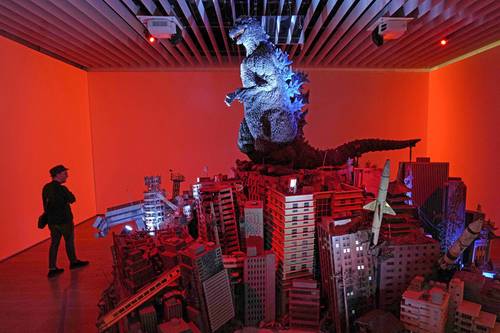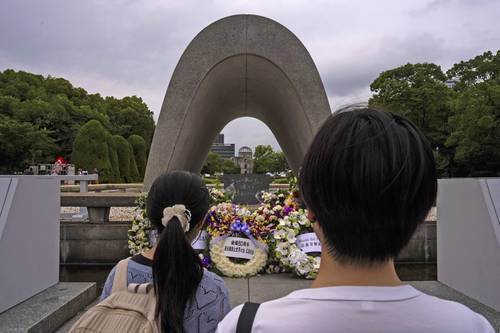The Hiroshima Panels, by Iri and Toshi Maruki, 80 years after the bombing

The Hiroshima Panels , by Iri and Toshi Maruki, 80 years after the bombing
In 1950 they began the first major public work dedicated to atomic attacks // It took them more than 30 years to complete it
Alejandra Ortiz Castañares
Special for La Jornada
La Jornada Newspaper, Tuesday, August 5, 2025, p. 2
Florence. Little Boy , the first atomic bomb dropped on a civilian population, devastated Hiroshima on August 6, 1945. Three days later, Fat Man destroyed Nagasaki. Both explosions caused the immediate deaths of approximately 240,000 people—38,000 of them children—according to data from the International Campaign to Abolish Nuclear Weapons, leaving physical and psychological scars on the survivors for decades. Hiroshima, the first city hit, has been inscribed as one of the great moral wounds of the 20th century.
The atomic bomb not only devastated people and cities: it left an indelible mark on the consciousness of artists, filmmakers and writers around the world. Among them, Salvador Dalí created the series Nuclear Mystique , in which he incorporated references to atomic structures and floating objects evoking the disintegration of matter, as in Madonna of Port Lligat (1950), now preserved in Japan. Andy Warhol addressed the catastrophe in his series Atomic Bomb (1965), while Gerhard Richter reinterpreted images of explosions and radiation in works such as Bombers (1963), in a context where the nuclear threat was permanent during the Cold War .
In Japan, however, it was two artists—a married couple—who witnessed the consequences of that destruction firsthand and captured them in enormous paintings divided into panels, reminiscent of traditional screens. They transformed their pain into a lifelong commitment to combating violence through their artwork and action, which earned them a nomination for the Nobel Peace Prize in 1995.
Iri Maruki (1901-1995), originally from Hiroshima, and Toshi Maruki (1912-2000), from Chippubetsu, Hokkaido, in northern Japan, began a series in 1950 that took over 30 years to complete, the Hiroshima Panels . Fourteen of these are housed at the Maruki Gallery in Saitama, north of Tokyo, where the artists made them permanently available to the public in 1967. The last of these, Nagasaki (1982), is housed in the Atomic Bomb Museum in that city, and copies of the complete series can be found at the Hiroshima Museum of Contemporary Art.
The series began as a trilogy – Ghosts , Fire and Water – created in 1950. The artists later added new panels, most from that decade, including Boys and Girls (1951), expanding the project to 15. Children were especially vulnerable victims: mobilized to build firebreaks, entire classes were wiped out, and many died of thirst by the riverside, unable to reach water, as described on the museum’s website (marukigallery.jp/en/hiroshimapanels).
With the intention of bringing the work to the United States, they made copies of the first triptych for fear that they would be damaged or lost. However, the exhibition was rejected in that country, underscoring the discomfort generated by the event and its powerful anti-war message.
The first six works were made during the Allied occupation and under a regime of censorship and a red purge
. Organized by the Communist Party, the initial exhibitions received a lukewarm response: the press was cautious about the political climate, and the collective trauma was still fresh. However, they soon aroused intense emotions wherever they were exhibited, touring Japan like sacred relics and provoking profound reactions from the public.
These monumental paintings constitute the first major public work dedicated to the subject, created with an explicit social and political purpose: to denounce atomic weapons and the violence of war. For Toshi, it was essential to confront this pain, for only by processing it would it be possible to create a bright and joyful Japan
.
Each canvas, measuring 180 by 720 centimeters, is a fusion of contrasts: Iri's traditional Japanese sumi ink technique with Toshi's Western-style ( yoga ) gestures. Compositional essence combined with mastery of stroke, tenderness, and cruelty.
The naked and vulnerable bodies of a defenseless population are not illustration: they are vibrating flesh, smelling of smoke and pain. The panels sweat. They scream. The human being appears reduced to a wreck, without shelter or dignity. The full weight of atomic irrationality hangs in a painful silence.
The copies made for shipment to the United States, although technically similar, didn't achieve the same expressive power, Toshi thought, admitting he was embarrassed to show them, as they lacked the energy of the originals. Even so, for years these versions circulated in Japan, due to the growing demand for exhibitions.
The Hiroshima Panels were considered mere graphic documents due to the social function they served, lacking the status of works of art. This devaluation persisted until 2002, when Setsuko Kozawa published a study that analyzed them using formal criteria, highlighting their expressive, compositional, and symbolic power.
Japan exorcises trauma with cultural expressions

▲ Godzilla: The Art , an exhibition commemorating the 70th anniversary of the fictional creature's birth at the Mori Arts Center Gallery in Tokyo. Photo by AFP

▲ Visitors in front of the cenotaph in memory of the victims, yesterday in Peace Park, in Hiroshima. Photo AFP
AFP
La Jornada Newspaper, Tuesday, August 5, 2025, p. 3
Tokyo. The nuclear bombs dropped on Hiroshima and Nagasaki have profoundly influenced Japanese culture for decades, inspiring everything from Godzilla's atomic breath to manga stories.
The Japanese title of the Astro Boy manga is Mighty Atom , while other famous anime such as Akira, Neon Genesis Evangelion and Attack on Titan feature large-scale explosions.
Going through extreme suffering
and exorcising trauma is a recurring theme in Japanese cultural production, and this has fascinated global audiences
, says William Tsutsui, a history professor at the University of Ottawa.
The American bombs dropped in August 1945 caused around 140,000 deaths in Hiroshima and 74,000 in Nagasaki.
Since the end of World War II, stories of destruction and mutation have been associated with the fear of frequent natural disasters and, after 2011, the Fukushima accident.
While some poems describe the sheer terror caused by the atomic bomb at the moment it was dropped
, many works address the subject indirectly, confirms writer Yoko Tawada.
In his book The Emissary , published in Japan in 2014, Tawada focuses on the aftermath of a major catastrophe, drawing inspiration from the similarities between the atomic bombs, Fukushima, and Minamata disease
, a mercury poisoning due to industrial pollution in southwestern Japan since the 1950s.
It's not so much a warning as a message: things may get worse, but we'll find a way to survive
, explains Tawada.
Giving a face to abstract fears
Godzilla is undoubtedly the most famous creation that reflects the complex relationship between Japan and nuclear energy: a prehistoric creature awakened by US atomic tests in the Pacific.
We need monsters to give form and face to abstract fears
, says Tsutsui, author of the book Godzilla in My Mind .
In the 1950s, Godzilla played that role for the Japanese, with atomic energy, with radiation, with memories of atomic bombs.
Many left the theater in tears after watching Godzilla ravage Tokyo in the original 1954 film.

▲ A 1945 photo showing the devastated city of Hiroshima after a U.S. Air Force B-29 dropped the first atomic bomb on August 6. Photo: AFP
The nuclear theme is present in the nearly 40 Godzilla films, but it is often not prominent in the plots.
The American public was not very interested in Japanese films that reflected the pain and suffering of war and, in some ways, made negative reference to the United States and its use of atomic bombs
, according to Tsutsui.
Despite all this, the franchise remains very popular, and Godzilla Resurge was a huge success in 2016. The film was perceived as a critique of the management of Fukushima.
Black rain
Black Rain , Masuji Ibuse's 1965 novel about radiation sickness and discrimination, is one of the best-known accounts of the Hiroshima bombing.
Ibuse was not a survivor, which fuels a huge debate about who has the legitimacy to write these kinds of stories
, explains Victoria Young of Cambridge University.
Kenzaburo Oe, writer and Nobel Prize winner for Literature in 1994, compiled testimonies from survivors in Hiroshima Notebooks , a collection of essays written in the 1960s.
Oe deliberately chose the documentary genre, notes Yoko Tawada. She confronts reality, but attempts to approach it from a personal perspective
, including her relationship with her disabled son, she adds.
Tawada lived in Germany for 40 years, after growing up in Japan.
The anti-militarist upbringing I received sometimes made me think that only Japan was a victim
during World War II, he says.
Regarding the bombings, Japan was certainly a victim,
but it is important to take a global view
and consider the atrocities it also committed.
As a child, illustrations of atomic bombings in books reminded her of descriptions of hell in classical Japanese art.
It led me to wonder whether human civilization wasn't itself a source of danger
, he emphasizes. From this perspective, atomic weapons wouldn't be so much a technological advance as something lurking within humanity
.
jornada





